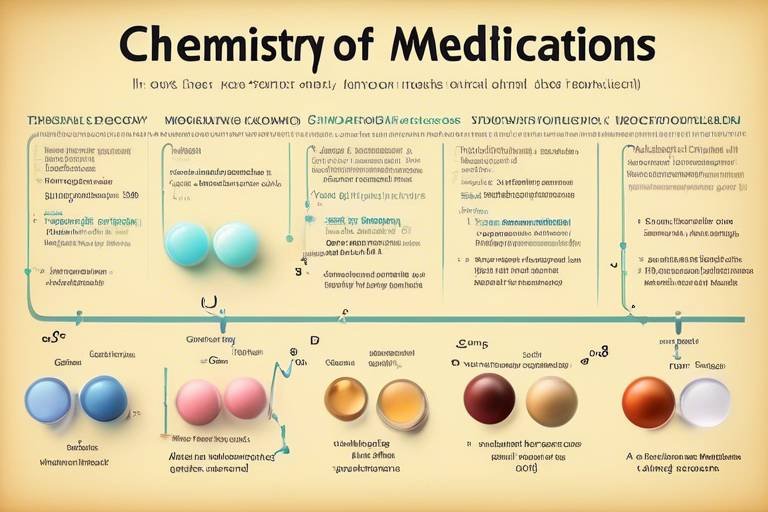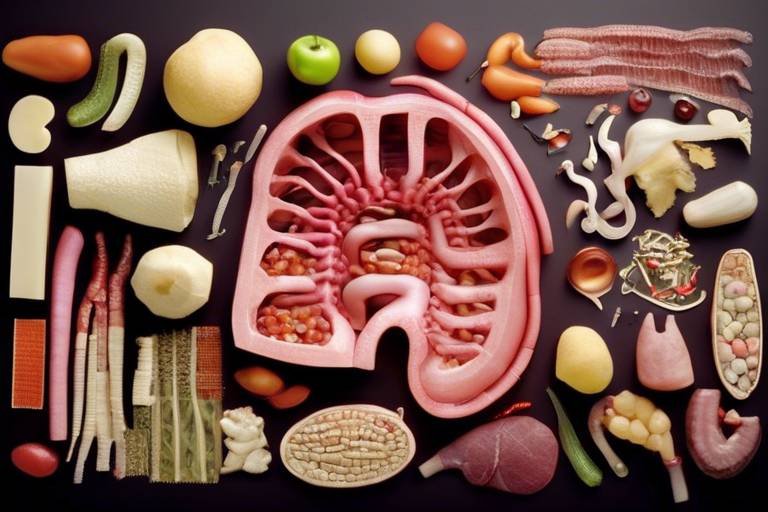The Chemistry of Plant Growth - Understanding Fertilizers
Welcome to the fascinating world of plant growth! If you've ever wondered how those vibrant flowers bloom or why your vegetables aren't thriving, you're in the right place. This article explores the essential role of fertilizers in plant growth, delving into their chemical composition, types, and how they affect soil health and plant development. Just like a chef needs the right ingredients to whip up a delicious meal, plants require specific nutrients to flourish. So, let’s dig deep into the chemistry of fertilizers and uncover the secrets behind healthy, thriving plants!
Nutrients are the backbone of plant health. Imagine trying to build a house without bricks; it just wouldn't stand! Similarly, plants rely on a mix of macronutrients and micronutrients to grow strong and healthy. The primary macronutrients include nitrogen (N), phosphorus (P), and potassium (K), often referred to as NPK. Each of these nutrients plays a unique role:
- Nitrogen: Essential for leaf growth and overall plant vigor.
- Phosphorus: Crucial for root development and flowering.
- Potassium: Aids in water regulation and disease resistance.
But that’s not all! Plants also need a variety of micronutrients like iron, manganese, and zinc, albeit in smaller amounts. These little guys are like the spices in your favorite dish—small but vital for enhancing flavor and overall quality. Without them, plants can suffer from deficiencies, leading to stunted growth and poor health.
Fertilizers come in various forms, each serving unique purposes, just like different tools in a gardener's shed. Understanding these types can help you choose the right one for your gardening practices. The two main categories are organic and inorganic fertilizers. Let’s take a closer look at each:
Organic fertilizers are derived from natural sources, making them a popular choice for those looking to garden sustainably. They not only provide nutrients but also improve soil structure and promote healthy microbial activity. Think of them as the slow-cooked meals of the fertilizer world—deliciously rich and full of flavor! Some common organic fertilizers include:
- Compost: A blend of decomposed organic matter that enriches soil health.
- Manure: Animal waste that offers a nutrient boost and enhances soil fertility.
Composting is like a magical transformation where kitchen scraps and yard waste become nutrient-rich soil amendments. The composting process involves the breakdown of organic materials by microorganisms, resulting in a dark, crumbly substance that is a gardener's best friend. It not only enriches the soil but also helps retain moisture, making it easier for plants to access water.
Animal manure is another form of organic fertilizer that packs a punch when it comes to nutrients. Rich in nitrogen, phosphorus, and potassium, manure can significantly enhance soil fertility. However, it’s essential to apply it correctly to avoid overwhelming plants. Proper composting of manure before use can also help eliminate pathogens, making it a safe choice for your garden.
On the flip side, inorganic fertilizers are synthetically manufactured to provide quick nutrient availability. They are like fast food for plants—quick and efficient, but they can come with potential downsides. Over-reliance on inorganic fertilizers can lead to soil degradation and environmental issues, such as runoff that pollutes waterways. Therefore, it’s crucial to balance their application with organic methods for sustainable farming.
Applying fertilizers correctly is crucial for effectiveness. Just like pouring salt into a dish, the right amount at the right time can make all the difference. There are several methods for applying fertilizers, including:
- Broadcasting: Spreading fertilizer evenly over the soil surface.
- Foliar Feeding: Applying liquid fertilizer directly to the leaves.
- Fertigation: Injecting fertilizer into the irrigation system for efficient nutrient delivery.
Each method has its own benefits and best practices, so it's essential to choose the right one based on your gardening needs.
Soil testing is like a health check-up for your garden. It helps determine nutrient deficiencies and allows you to tailor fertilizer applications to meet specific plant needs. Conducting a soil test is simple and can provide valuable insights into what your plants are craving. Once you have the results, you can make informed decisions about what fertilizers to use, ensuring your plants get exactly what they need to thrive.
The timing and frequency of fertilizer applications can significantly impact plant growth. Just like watering your plants too often can drown them, applying fertilizer at the wrong time can hinder their development. Generally, it's best to fertilize during the growing season when plants are actively taking up nutrients. Following a schedule based on your plants' growth stages can lead to optimal results.
While fertilizers enhance plant growth, they can also affect the environment. Issues such as runoff, soil degradation, and nutrient leaching can pose significant challenges. To minimize these impacts, consider implementing sustainable practices like:
- Using cover crops to improve soil health.
- Practicing crop rotation to maintain nutrient balance.
- Applying fertilizers at the right rates and times to reduce runoff.
By being mindful of your gardening practices, you can enjoy the benefits of fertilizers while protecting our precious environment.
1. What are the signs of nutrient deficiencies in plants?
Common signs include yellowing leaves, stunted growth, and poor flowering. Each nutrient deficiency has specific symptoms, so it’s essential to observe your plants closely.
2. How often should I fertilize my plants?
The frequency of fertilization depends on the type of plants and their growth stage. Generally, during the growing season, fertilizing every 4-6 weeks is a good rule of thumb.
3. Can I use both organic and inorganic fertilizers together?
Yes! A balanced approach using both types can provide the best results for your plants while promoting soil health.
4. Is it necessary to test my soil before applying fertilizers?
While it’s not mandatory, soil testing is highly recommended. It helps you understand the specific nutrient needs of your soil and prevents over-fertilization.

The Role of Nutrients in Plant Growth
Nutrients are the lifeblood of plants, playing a crucial role in their growth and overall health. Just like humans need a balanced diet to thrive, plants require a specific combination of nutrients to flourish. These nutrients can be broadly categorized into two groups: macronutrients and micronutrients. Each type serves distinct functions that contribute to the plant's development, resilience, and productivity.
Macronutrients are the primary building blocks for plant growth. They include nitrogen (N), phosphorus (P), and potassium (K), often referred to as the N-P-K trio. Nitrogen is essential for the production of chlorophyll, the green pigment that enables photosynthesis. Without it, plants can become stunted and yellowed, resembling a tired, undernourished version of themselves. Phosphorus, on the other hand, plays a vital role in energy transfer and root development, helping plants establish a strong foundation. Lastly, potassium is crucial for regulating water uptake and enzyme activation, ensuring that plants can efficiently utilize the nutrients they absorb.
In addition to these macronutrients, plants also require a smaller amount of micronutrients, which, despite their name, are no less important. These include elements like iron, manganese, zinc, and copper. Each micronutrient plays a specific role, such as aiding in photosynthesis, enzyme function, and overall cellular health. For instance, iron is essential for chlorophyll synthesis, and a deficiency can lead to chlorosis, a condition where leaves turn yellow while veins remain green, signaling a nutrient imbalance.
To give you a clearer picture of how these nutrients work together, consider the following table:
| Nutrient | Role in Plant Growth | Deficiency Symptoms |
|---|---|---|
| Nitrogen (N) | Essential for chlorophyll production and leafy growth | Yellowing leaves, stunted growth |
| Phosphorus (P) | Supports root development and energy transfer | Purple coloration on leaves, poor flowering |
| Potassium (K) | Regulates water uptake and enzyme activation | Wilting, browning leaf edges |
| Iron (Fe) | Important for chlorophyll synthesis | Yellowing between leaf veins (chlorosis) |
| Zinc (Zn) | Involved in enzyme function and growth regulation | Stunted growth, leaf curling |
Understanding the roles of these nutrients is just the beginning. It's also important to recognize that nutrient availability can be influenced by various factors, such as soil pH, organic matter content, and microbial activity. Healthy soil teems with life, including bacteria and fungi that help break down organic matter and release nutrients in forms that plants can absorb. Therefore, maintaining soil health is paramount for ensuring that plants have access to the nutrients they need.
In conclusion, the role of nutrients in plant growth cannot be overstated. They are the unseen forces that drive the vibrant life of plants, enabling them to grow, reproduce, and thrive. By understanding their importance and ensuring that plants receive a balanced supply of both macronutrients and micronutrients, gardeners can cultivate lush, healthy gardens that not only beautify our surroundings but also contribute to the ecosystem.
Q: What are the signs of nutrient deficiency in plants?
A: Common signs include yellowing leaves, stunted growth, and poor flowering. Each nutrient deficiency has specific symptoms, so it's important to identify which nutrient may be lacking.
Q: How can I ensure my plants receive the right nutrients?
A: Conducting soil tests can help you determine nutrient levels and deficiencies. Based on the results, you can choose the appropriate fertilizers to amend your soil.
Q: Are organic fertilizers better than synthetic ones?
A: Both have their pros and cons. Organic fertilizers improve soil structure and promote sustainability, while synthetic fertilizers provide quick nutrient availability. The best choice depends on your gardening goals.

When it comes to nurturing plants, understanding the types of fertilizers available is crucial. Fertilizers are not just a one-size-fits-all solution; they come in various forms, each tailored to meet specific needs of plants and soil. Whether you're a seasoned gardener or a newbie trying to get your first tomato plant to thrive, knowing your options can make all the difference.
In the world of fertilizers, we primarily categorize them into three main types: organic fertilizers, inorganic fertilizers, and slow-release fertilizers. Each type has its own unique characteristics, benefits, and drawbacks that can significantly affect your gardening practices.
Organic fertilizers are derived from natural sources, such as plant and animal matter. They are often favored for their ability to improve soil structure and promote sustainable gardening practices. When you use organic fertilizers, you’re not just feeding your plants; you're also enriching the entire ecosystem of your garden. For example, compost, a popular organic fertilizer, is made from decomposed organic matter, providing a slow and steady release of nutrients that plants can absorb over time.
On the other hand, inorganic fertilizers are synthetically manufactured and are known for their quick nutrient availability. They can deliver a concentrated dose of essential nutrients directly to your plants, which can lead to rapid growth. However, this quick-release nature can also pose risks. If not applied correctly, inorganic fertilizers can lead to nutrient runoff, which can harm local waterways and ecosystems. Therefore, a balanced approach to application is essential for sustainable farming practices.
Then we have slow-release fertilizers, which bridge the gap between organic and inorganic options. These fertilizers are designed to release nutrients gradually over time, providing a steady supply to plants without the risk of over-fertilization. This makes them an excellent choice for busy gardeners who might forget to fertilize regularly. However, they may require a bit more planning and understanding of your plants' nutrient needs to use effectively.
To give you a clearer picture, here’s a simple comparison table:
| Type of Fertilizer | Source | Release Rate | Environmental Impact |
|---|---|---|---|
| Organic | Natural (plant/animal matter) | Slow | Low (if managed properly) |
| Inorganic | Synthetic | Fast | High (risk of runoff) |
| Slow-release | Combination | Moderate | Moderate (if applied correctly) |
In summary, the type of fertilizer you choose can have a profound impact on your gardening success. By understanding the differences between organic, inorganic, and slow-release fertilizers, you can make informed decisions that not only benefit your plants but also contribute to the health of your soil and the environment.
- What is the best type of fertilizer for my garden? It depends on your plants' needs and your gardening practices. Organic fertilizers are great for sustainable gardening, while inorganic options offer quick results.
- Can I use both organic and inorganic fertilizers together? Yes, but be careful with the amounts. A balanced approach can provide the benefits of both.
- How often should I fertilize my plants? This varies by plant type and fertilizer used. Generally, it’s best to fertilize during the growing season and follow the specific recommendations for your chosen fertilizer.

Organic fertilizers are a fantastic way to nourish your plants while also caring for the environment. Derived from natural sources such as animal manure, compost, and plant materials, these fertilizers are rich in nutrients and beneficial microorganisms that promote healthy soil and plant growth. Unlike their synthetic counterparts, organic fertilizers release nutrients slowly, allowing plants to absorb them over time. This slow-release mechanism not only prevents nutrient leaching but also improves soil structure and enhances its ability to retain moisture.
One of the most significant benefits of using organic fertilizers is their ability to improve soil health. They help to build a diverse ecosystem in the soil, fostering a community of beneficial bacteria and fungi that contribute to nutrient cycling. This is crucial because healthy soil is the foundation of a thriving garden. When you use organic fertilizers, you’re not just feeding your plants; you’re also feeding the soil, which in turn feeds your plants. It's a beautiful cycle!
Another advantage is that organic fertilizers can enhance the soil's water retention capacity. This is particularly important in areas prone to drought, where every drop of water counts. By improving soil structure, organic fertilizers help create a sponge-like environment, which can hold moisture and provide it to plants during dry spells. Imagine your garden as a well-prepared sponge, ready to soak up every bit of water available!
However, it’s essential to understand that organic fertilizers come with their own set of challenges. For instance, the nutrient content can vary significantly depending on the source. This variability means that you might need to conduct soil tests to determine the right type of organic fertilizer for your specific needs. Additionally, the nutrient release rates can be slower than those of inorganic fertilizers, which may require more frequent applications to meet the plants' immediate needs.
Here are some common types of organic fertilizers and their benefits:
- Compost: Rich in nutrients, compost improves soil structure and provides a balanced nutrient profile.
- Animal Manure: High in nitrogen, phosphorus, and potassium, manure also introduces beneficial microbes to the soil.
- Bone Meal: A great source of phosphorus, bone meal supports root development and flowering.
- Fish Emulsion: Packed with nutrients, fish emulsion is an excellent liquid fertilizer that promotes rapid growth.
In summary, organic fertilizers are not just a trend; they are a sustainable choice for gardening enthusiasts. By choosing organic, you're investing in the health of your plants and the environment. Just remember, like any good relationship, it takes time and understanding to find the right balance and nurture growth. So, are you ready to embrace the power of organic fertilizers in your gardening journey?
Q: What are organic fertilizers made from?
A: Organic fertilizers are made from natural materials like animal manure, compost, bone meal, and plant residues.
Q: How do organic fertilizers benefit the soil?
A: They improve soil structure, enhance microbial activity, and increase the soil's ability to retain moisture.
Q: Can I use organic fertilizers in all types of gardening?
A: Yes, organic fertilizers are suitable for all types of gardening, including vegetable gardens, flower beds, and lawns.
Q: How often should I apply organic fertilizers?
A: The frequency of application depends on the type of fertilizer and the specific needs of your plants. Generally, it's recommended to apply organic fertilizers every 4-6 weeks during the growing season.

Composting is one of the most effective and sustainable ways to enrich your garden soil. When you think about it, composting is like nature's recycling program, transforming organic waste into a treasure trove of nutrients that plants crave. But what exactly is compost, and why should you consider it as a fertilizer? Let’s dive into the process and benefits of composting!
At its core, compost is decomposed organic matter, often made from kitchen scraps, yard waste, and other biodegradable materials. This rich, dark substance is packed with essential nutrients that plants need to thrive. By creating a compost pile or bin, you’re essentially creating an ecosystem where microorganisms break down the organic material, resulting in a nutrient-dense soil amendment. The best part? It’s not just beneficial for your plants; it also helps reduce landfill waste and promotes a healthier environment.
One of the standout features of compost is its ability to improve soil structure. When you mix compost into your garden soil, it enhances aeration and drainage, allowing roots to grow deeper and access more nutrients and water. Think of compost as a sponge, soaking up moisture and holding it in the soil, which is especially crucial during dry spells. This moisture retention can significantly reduce the need for frequent watering, saving you time and resources.
Moreover, compost is a slow-release fertilizer. Unlike synthetic fertilizers that can provide a quick nutrient boost, compost gradually releases nutrients as it continues to break down. This slow release means that your plants can absorb nutrients over an extended period, leading to healthier growth and development. Additionally, the microorganisms in compost help to improve soil fertility and promote a vibrant ecosystem in your garden.
Now, you might be wondering how to get started with composting. Here are some simple steps to create your own compost:
- Choose a compost bin: You can buy one or make your own using wood pallets or wire mesh.
- Gather materials: Collect a mix of 'green' materials (like vegetable scraps and grass clippings) and 'brown' materials (such as dried leaves and cardboard).
- Layer your compost: Alternate layers of green and brown materials to create a balanced compost pile.
- Moisten and turn: Keep the pile moist (but not soggy) and turn it regularly to aerate and speed up the decomposition process.
In just a few months, you’ll have rich, dark compost ready to be added to your garden beds or potted plants. But remember, patience is key! The composting process takes time, but the rewards are well worth the wait.
In conclusion, composting is an excellent way to recycle organic waste while providing your plants with the nutrients they need to flourish. It’s a win-win situation: you contribute to a healthier planet while creating a thriving garden. So, why not give it a try? Your plants will thank you!
1. What materials can I compost?
Most kitchen scraps (fruits, vegetables, coffee grounds) and yard waste (leaves, grass clippings) are great for composting. Avoid meat, dairy, and oily foods as they can attract pests.
2. How long does it take for compost to be ready?
Compost can take anywhere from a few weeks to several months to break down, depending on the materials used and how often you turn the pile.
3. Can I use compost for all plants?
Yes! Compost is safe for all types of plants and can be used in garden beds, pots, and even lawns.
4. How much compost should I use?
A general rule of thumb is to mix about 1 part compost to 3 parts soil when planting or top-dressing existing plants.

When it comes to enriching soil and promoting healthy plant growth, animal manure stands out as a powerhouse of nutrients. Derived from livestock, this organic fertilizer has been used for centuries, and its benefits are as numerous as they are significant. One of the primary advantages of using manure is its ability to improve soil structure. By enhancing the soil's texture, manure helps retain moisture and nutrients, creating a thriving environment for plant roots.
Moreover, manure is rich in essential nutrients like nitrogen, phosphorus, and potassium, which are crucial for plant development. These macronutrients play a vital role in various physiological processes, such as photosynthesis and energy transfer. However, the nutrient content can vary widely depending on the type of animal and its diet. For instance, cow manure tends to be higher in nitrogen, while poultry manure is often richer in phosphorus. Understanding the specific nutrient profile can help gardeners tailor their fertilizer strategies effectively.
Another significant benefit of manure is its ability to boost microbial activity in the soil. The organic matter present in manure serves as a food source for beneficial microorganisms, which in turn break down nutrients into forms that plants can easily absorb. This not only enhances nutrient availability but also promotes a healthy ecosystem within the soil, fostering better plant growth.
However, it's essential to apply manure correctly to maximize its benefits and minimize potential downsides. Fresh manure can contain pathogens and high levels of nitrogen that can burn plants if applied directly. Therefore, it’s advisable to compost manure before application. Composting not only kills harmful pathogens but also stabilizes nutrients, making them more accessible to plants. The composting process typically involves:
- Collecting manure and mixing it with carbon-rich materials, such as straw or leaves.
- Maintaining moisture levels and turning the pile regularly to aerate it.
- Allowing the mixture to decompose over several months until it transforms into dark, crumbly compost.
Once properly composted, manure can be applied to gardens, lawns, and fields, providing a slow-release source of nutrients that supports sustained plant growth. Additionally, the application of manure can help sequester carbon in the soil, contributing to sustainable agricultural practices and combating climate change.
In conclusion, utilizing manure as a natural fertilizer not only enriches the soil but also supports a healthy ecosystem. By understanding its benefits and applying it wisely, gardeners and farmers can cultivate thriving plants while promoting environmental sustainability.
- What types of manure are best for gardening? Cow, chicken, and horse manure are popular choices, each offering different nutrient profiles.
- How should I apply manure to my garden? It's best to compost manure before applying it to avoid burning plants and to ensure nutrient stability.
- Can I use fresh manure directly on my plants? It's not recommended, as fresh manure can contain pathogens and high nitrogen levels that may harm plants.
- How often should I apply manure? Generally, once or twice a year is sufficient, depending on your soil's nutrient needs and the type of plants you are growing.

Inorganic fertilizers are synthetically manufactured products that provide essential nutrients to plants in a readily available form. Unlike their organic counterparts, these fertilizers are often concentrated and deliver nutrients quickly, making them popular among gardeners and farmers who seek immediate results. However, the rapid nutrient release can come with its own set of challenges and considerations.
One of the primary advantages of inorganic fertilizers is their ability to supply nutrients in precise quantities. This is particularly beneficial for crops that require specific nutrient ratios to thrive. For example, the three main macronutrients found in fertilizers are nitrogen (N), phosphorus (P), and potassium (K), often referred to as NPK. These nutrients play crucial roles in plant health:
| Nutrient | Function |
|---|---|
| Nitrogen (N) | Promotes leafy growth and overall plant vigor. |
| Phosphorus (P) | Essential for root development and flower/fruit production. |
| Potassium (K) | Improves drought resistance and enhances overall plant health. |
While inorganic fertilizers can boost plant growth significantly, they also pose potential environmental risks. When applied excessively or improperly, these fertilizers can lead to nutrient runoff, which contaminates local water sources. This runoff can cause algal blooms, depleting oxygen levels in water bodies and harming aquatic life. Therefore, it is crucial to apply these fertilizers judiciously and in accordance with soil test results.
Another important aspect to consider is the balance of nutrient application. Over-reliance on inorganic fertilizers can lead to soil degradation over time, as they do not contribute organic matter to the soil. This is where a mixed approach can be beneficial. Incorporating organic fertilizers alongside inorganic ones can improve soil structure, enhance microbial activity, and promote long-term soil health.
In summary, inorganic fertilizers are a powerful tool in modern agriculture and gardening. They offer quick nutrient availability and precise application, which can lead to impressive plant growth. However, responsible use is essential to prevent environmental harm and ensure sustainable practices. As we move forward, finding a balance between inorganic and organic fertilizers will be key to achieving healthy plants and a thriving ecosystem.

Applying fertilizers correctly is crucial for maximizing their effectiveness and ensuring that plants receive the nutrients they need to thrive. Just like a chef must know how to season their dish for the perfect flavor, gardeners must understand the methods of fertilizer application to nourish their plants properly. There are several methods to consider, each with its own set of advantages and best practices. Let’s dive into some of the most common techniques!
One popular method is broadcasting, which involves spreading fertilizer evenly over the soil surface. This technique is often used for large areas, such as lawns or crop fields, where even distribution is essential. The beauty of broadcasting lies in its simplicity; however, it requires careful timing and weather considerations to prevent nutrient loss due to runoff or evaporation. Think of it like throwing seeds into the wind—if done at the right moment, they’ll land in the perfect spot!
Another effective method is foliar feeding, where a liquid fertilizer is sprayed directly onto the leaves of the plants. This approach allows for quick nutrient absorption, as leaves can take in nutrients much faster than roots in some cases. Foliar feeding is particularly beneficial for addressing specific nutrient deficiencies, providing a fast-acting solution when plants show signs of stress. Imagine giving your plants a refreshing drink on a hot day; they’ll perk right up!
Then we have fertigation, a method that combines fertilization with irrigation. This technique is often used in commercial agriculture and large-scale gardening. By mixing fertilizers with water and delivering them directly to the root zone through irrigation systems, fertigation ensures that nutrients are available to plants when they need them most. It’s like having a nutrient-packed smoothie delivered right to your doorstep—convenient and effective!
To help you decide which method might be best for your gardening needs, here’s a quick comparison table:
| Application Method | Advantages | Considerations |
|---|---|---|
| Broadcasting | Easy to apply over large areas. | Risk of runoff; timing is crucial. |
| Foliar Feeding | Quick nutrient absorption; targeted application. | Requires careful mixing; can be labor-intensive. |
| Fertigation | Efficient use of water and nutrients; reduces waste. | Requires irrigation setup; initial investment may be high. |
Regardless of the method you choose, it’s essential to keep in mind the specific needs of your plants and the characteristics of your soil. A well-planned application strategy can lead to healthier plants, increased yields, and a more vibrant garden. Just like a tailored suit fits better than an off-the-rack option, customized fertilizer application can make all the difference!
- What is the best time to apply fertilizers? Generally, early spring and late fall are ideal times for most plants, but it varies based on the type of plants and fertilizers used.
- Can I apply fertilizers during rainy weather? It’s best to avoid applying fertilizers just before heavy rain to reduce runoff and nutrient loss.
- How often should I fertilize my plants? This depends on the plant type and growth stage, but a general rule is to fertilize every 4-6 weeks during the growing season.

Understanding the nutrient needs of your plants is like having a roadmap for a successful garden. Just as you wouldn’t embark on a road trip without knowing your destination, you shouldn’t start planting without testing your soil. Soil testing is a crucial step in determining what nutrients are present and what might be lacking. It’s the best way to tailor your fertilizer applications to meet the specific needs of your plants, ensuring they thrive.
So, how do you conduct a soil test? The process is straightforward and can be done in a few easy steps. First, you’ll need to collect soil samples from various spots in your garden. Aim for at least 10-15 samples, mixing them together to create a composite sample that represents your garden's overall condition. Once you have your sample, you can send it to a local agricultural extension office or a private lab for analysis. The results will provide you with a wealth of information, including pH levels, nutrient concentrations, and organic matter content.
Interpreting soil test results can seem daunting, but it’s essential for effective fertilization. Most test reports will include a breakdown of macronutrients like nitrogen (N), phosphorus (P), and potassium (K), along with micronutrients such as iron (Fe) and zinc (Zn). Here’s a quick overview of what these nutrients do:
| Nutrient | Function |
|---|---|
| Nitrogen (N) | Promotes leafy growth and overall plant vigor. |
| Phosphorus (P) | Supports root development and flowering. |
| Potassium (K) | Enhances drought resistance and overall plant health. |
| Iron (Fe) | Essential for chlorophyll production and photosynthesis. |
| Zinc (Zn) | Important for enzyme function and growth regulation. |
Once you have a clear understanding of the nutrient levels in your soil, you can make informed decisions about which fertilizers to apply. For instance, if your soil is low in nitrogen, opting for a nitrogen-rich fertilizer will help boost your plants' growth. Conversely, if phosphorus levels are adequate, you might consider a balanced fertilizer that doesn’t overemphasize this nutrient.
Additionally, consider the timing of your fertilizer applications. Soil tests can help identify when your plants will need specific nutrients the most. For example, if your test indicates a deficiency in potassium right before the flowering season, applying a potassium-rich fertilizer can significantly enhance flower production and fruit set.
Remember, the key to successful gardening lies not just in the quantity of fertilizer you apply but in the quality of your understanding of your soil's needs. By regularly testing your soil and adjusting your fertilization strategy accordingly, you’ll not only support the health of your plants but also contribute to sustainable gardening practices. Healthy soil leads to healthy plants, and ultimately, a thriving garden.
- How often should I test my soil? It's recommended to test your soil every 2-3 years, or annually if you're growing high-demand crops.
- Can I do a soil test myself? While home kits are available, sending your sample to a lab provides more accurate results.
- What should I do if my soil is too acidic or alkaline? Amend the soil with lime to raise pH or sulfur to lower it, based on your soil test results.

When it comes to achieving a lush, vibrant garden, understanding fertilizer timing and frequency is absolutely crucial. Think of it like cooking a gourmet meal; you wouldn't just throw all the ingredients into the pot at once, right? Similarly, plants have specific windows when they can absorb nutrients most effectively. Applying fertilizers at the right time can mean the difference between a thriving garden and a lackluster one.
First off, let's talk about the growing season. Most plants have a defined growing season, and this is when they need nutrients the most. For instance, spring is the prime time for most plants to kickstart their growth after the dormancy of winter. During this period, you should consider applying a balanced fertilizer to provide them with the essential nutrients they crave. As the season progresses into summer, plants will continue to require nourishment, but the type and amount of fertilizer might need adjustment based on their growth stage.
Another key factor to consider is the plant type. Different plants have different nutrient needs. For example, leafy greens like lettuce thrive on nitrogen-rich fertilizers, while flowering plants might benefit more from phosphorus. This means that knowing your plants and their specific requirements is essential. You wouldn’t want to give a cactus the same fertilizer as a rose, right? Tailoring your approach not only optimizes growth but also prevents nutrient burn, which can occur if too much fertilizer is applied at once.
Now, let's dive into the frequency of application. Generally, it's recommended to fertilize every 4-6 weeks during the growing season. However, this can vary based on the type of fertilizer you use. For example, organic fertilizers often release nutrients more slowly, allowing for less frequent applications compared to their inorganic counterparts, which provide a quick nutrient boost. A good rule of thumb is to always follow the manufacturer's guidelines on the fertilizer packaging.
To help visualize the timing and frequency of fertilizer applications, here’s a simple table:
| Fertilizer Type | Application Frequency | Best Time to Apply |
|---|---|---|
| Organic Fertilizer | Every 6-8 weeks | Spring and early summer |
| Inorganic Fertilizer | Every 4-6 weeks | Throughout the growing season |
| Slow-Release Fertilizer | Once every 3 months | Early spring |
Lastly, don't forget about the importance of weather conditions. Rain can wash away fertilizers, while dry spells can hinder nutrient absorption. It's wise to monitor the weather and adjust your fertilization schedule accordingly. If a heavy rain is forecasted soon after application, consider waiting until after the rain to apply your fertilizer. This way, you maximize the benefits and minimize waste.
In summary, the timing and frequency of fertilizer applications can significantly influence plant health and productivity. By understanding the growing season, plant types, and environmental factors, you can create a customized fertilization plan that ensures your garden flourishes. So, get out there and give your plants the love and nutrients they deserve!
- How do I know when to fertilize my plants? Monitor the growing season and plant health; generally, spring is a great time to start.
- Can I over-fertilize my plants? Yes, over-fertilization can lead to nutrient burn and harm your plants.
- What type of fertilizer is best for my garden? It depends on your plant types; leafy greens prefer nitrogen, while flowering plants benefit from phosphorus.
- How often should I test my soil? It's advisable to test your soil at least once a year to understand its nutrient profile.

While fertilizers play a crucial role in enhancing plant growth and increasing agricultural productivity, their use can also lead to significant environmental challenges. Understanding these impacts is essential for sustainable gardening and farming practices. One of the primary concerns is nutrient runoff, which occurs when excess fertilizers wash away from the fields into nearby water bodies during rainfall or irrigation. This runoff can lead to a phenomenon known as eutrophication, where nutrient overloads cause algal blooms. These blooms can deplete oxygen levels in the water, creating "dead zones" where aquatic life cannot survive.
Moreover, the over-application of fertilizers can lead to soil degradation. Over time, excessive use can disrupt the natural balance of soil microorganisms, essential for maintaining soil health. This disruption can result in reduced soil fertility, making it harder for plants to access the nutrients they need. The long-term effects can be detrimental, not only to plant health but also to the broader ecosystem, as healthy soil is vital for water filtration and carbon sequestration.
Another environmental concern is the impact of fertilizers on air quality. Certain fertilizers release gases, such as ammonia and nitrous oxide, into the atmosphere. These emissions contribute to air pollution and can have harmful effects on human health and the environment. For example, nitrous oxide is a potent greenhouse gas, significantly contributing to climate change.
To mitigate these negative effects, it's essential to adopt more sustainable fertilizer practices. Here are a few strategies:
- Soil Testing: Regularly testing soil can help determine the specific nutrient needs of your plants, allowing for more targeted and efficient fertilizer application.
- Precision Agriculture: Utilizing technology to apply fertilizers more accurately can reduce waste and minimize runoff.
- Buffer Zones: Creating vegetative buffer zones around fields can help absorb excess nutrients before they reach water bodies.
In conclusion, while fertilizers are indispensable for modern agriculture, their environmental impact cannot be overlooked. By implementing responsible practices, we can enjoy the benefits of fertilizers while minimizing their adverse effects on our planet.
- What are the signs of over-fertilization in plants? Over-fertilization can lead to leaf burn, stunted growth, and even plant death. Yellowing leaves and salt crust on the soil surface are common indicators.
- How can I reduce fertilizer runoff? Implementing buffer strips, practicing crop rotation, and using cover crops can significantly reduce runoff.
- Are organic fertilizers better for the environment? Generally, organic fertilizers have less risk of runoff and improve soil health over time, making them a more sustainable choice.
Frequently Asked Questions
- What are the primary nutrients required for plant growth?
Plants need a variety of nutrients to thrive, with the primary macronutrients being nitrogen (N), phosphorus (P), and potassium (K). These nutrients play crucial roles in processes like photosynthesis, root development, and overall plant health. Micronutrients, though needed in smaller amounts, such as iron, manganese, and zinc, are equally important for various physiological functions.
- What is the difference between organic and inorganic fertilizers?
Organic fertilizers are derived from natural sources like compost, manure, or bone meal, and they improve soil health over time. In contrast, inorganic fertilizers are synthetically manufactured and provide quick nutrient availability. Both types have their benefits and drawbacks, and choosing the right one depends on your gardening practices and goals.
- How can I improve soil health using fertilizers?
To enhance soil health, consider using organic fertilizers such as compost or well-rotted manure. These not only supply essential nutrients but also improve soil structure and promote beneficial microbial activity. Regular soil testing can help you identify nutrient deficiencies and adjust your fertilizer applications accordingly.
- What are the best methods for applying fertilizers?
There are several effective methods for applying fertilizers, including broadcasting, foliar feeding, and fertigation. Broadcasting involves spreading fertilizers evenly over the soil surface, while foliar feeding targets the leaves directly. Fertigation combines fertilization with irrigation, allowing for efficient nutrient delivery. Each method has its own advantages, so choose one that fits your gardening style.
- How often should I fertilize my plants?
The frequency of fertilization largely depends on the type of plants you are growing and their specific nutrient needs. Generally, it's recommended to fertilize during the growing season, which can be every 4-6 weeks for most plants. However, always follow the guidelines based on soil tests and the specific requirements of your plants for optimal results.
- What are the environmental impacts of using fertilizers?
While fertilizers can boost plant growth, they can also lead to environmental issues like runoff, which may contaminate water sources, and soil degradation over time. To minimize these impacts, practice responsible fertilization by following recommended application rates, timing, and methods, and consider integrating organic options into your routine.



















